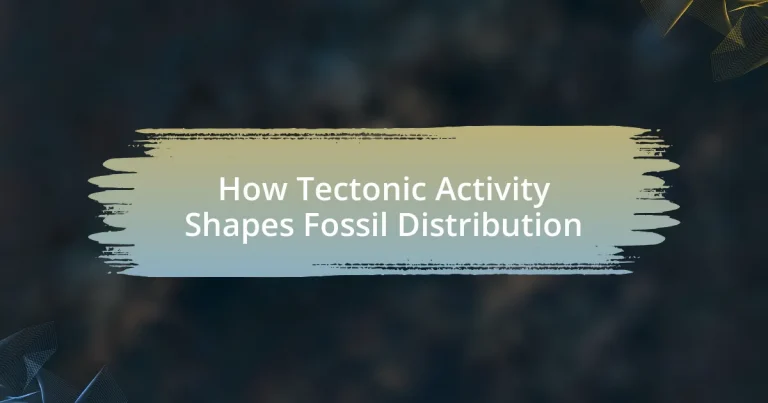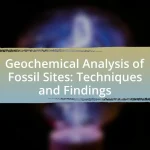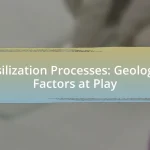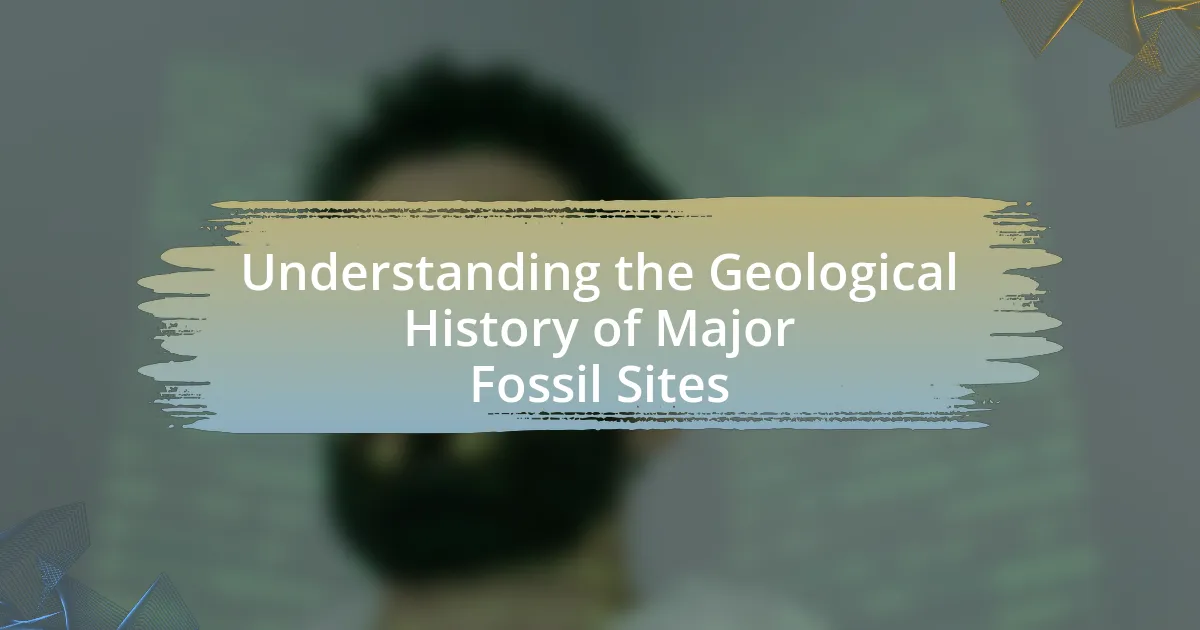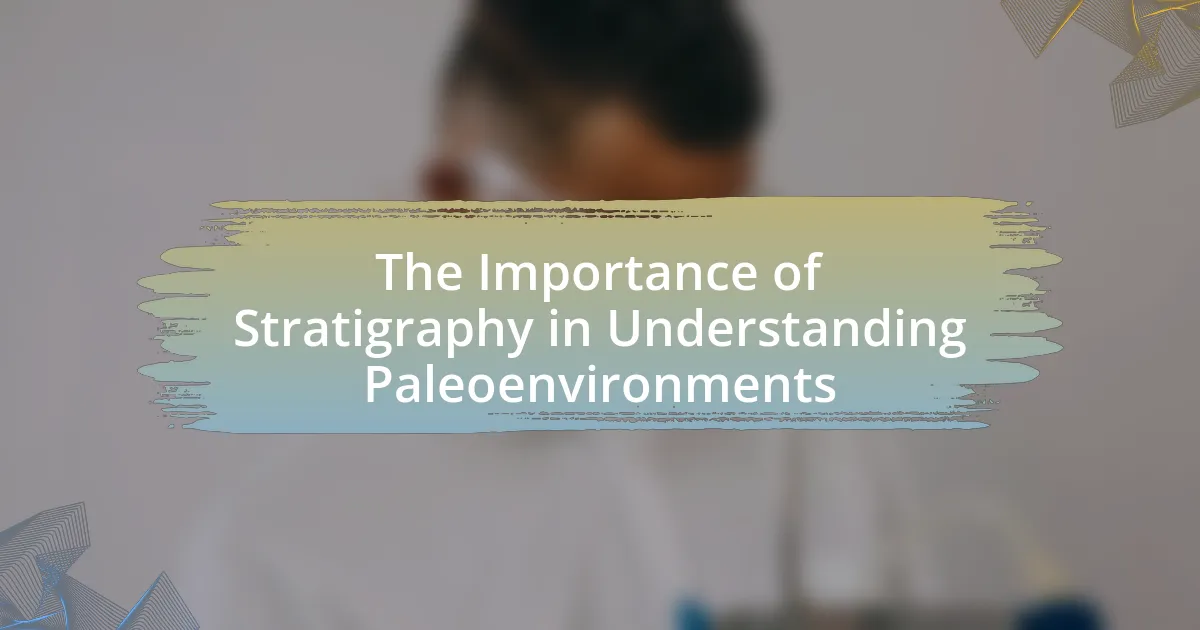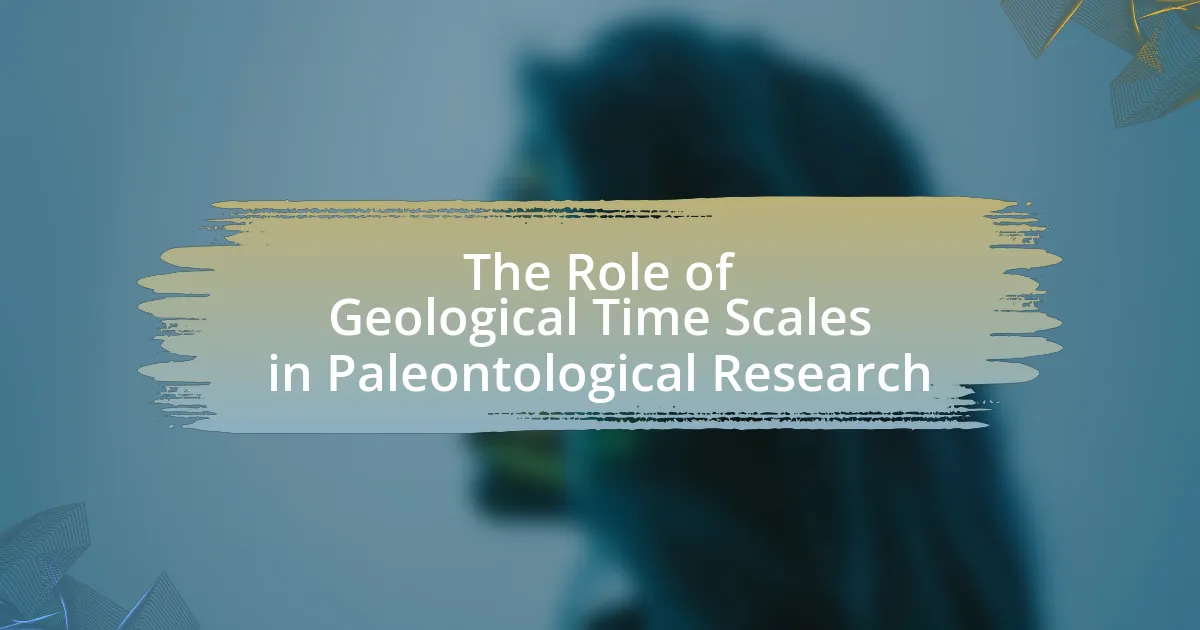Tectonic activity plays a crucial role in shaping fossil distribution by altering geological landscapes, which affects sediment deposition and the accessibility of fossil sites. The article examines how different types of tectonic boundaries—divergent, convergent, and transform—impact geological formations and, consequently, the environments where organisms live and die. It explores the mechanisms linking tectonic movements to fossil distribution, including continental drift, mountain building, and volcanic activity, while also discussing the implications for understanding Earth’s history, ancient biodiversity, and conservation efforts. Additionally, the article highlights the challenges researchers face in studying this relationship and the technological advancements that aid in fossil analysis.
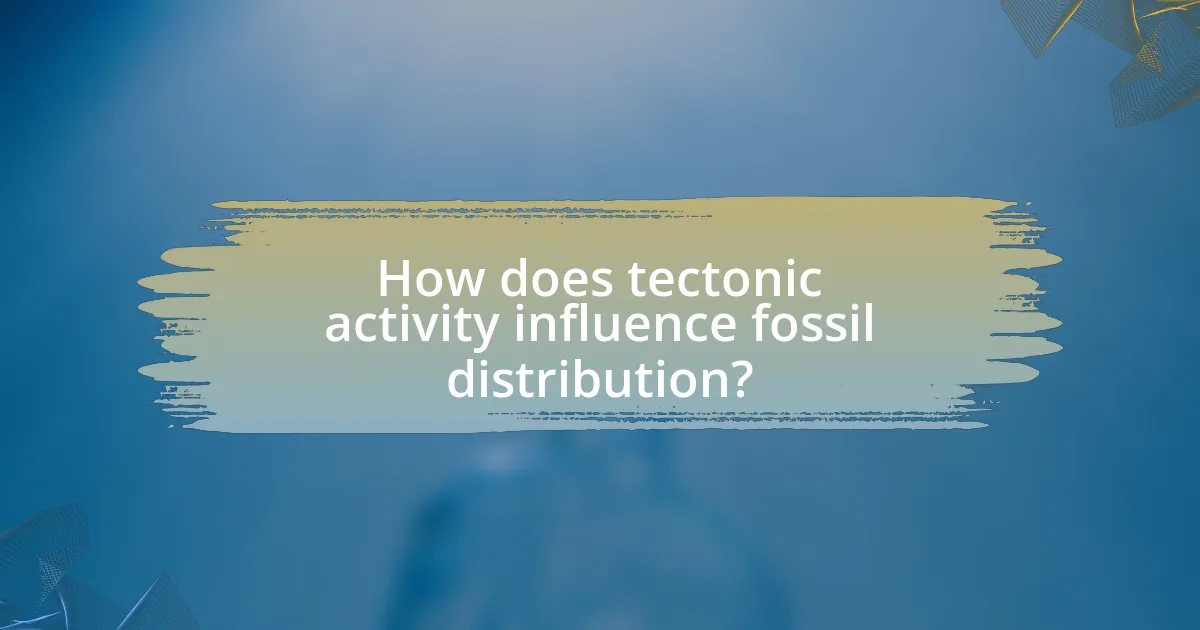
How does tectonic activity influence fossil distribution?
Tectonic activity influences fossil distribution by altering the geological landscape, which affects sediment deposition and the accessibility of fossil sites. When tectonic plates shift, they can create mountains, valleys, and ocean basins, leading to changes in environmental conditions that determine where organisms can live and, subsequently, where their fossils may be found. For example, the uplift of mountain ranges can expose older sedimentary layers containing fossils, while subduction zones can lead to the destruction of fossil-bearing strata. Additionally, tectonic movements can cause the fragmentation of habitats, isolating populations and affecting evolutionary processes, which in turn influences the types of fossils that are preserved in different regions.
What are the primary types of tectonic activity?
The primary types of tectonic activity are divergent, convergent, and transform boundaries. Divergent boundaries occur where tectonic plates move apart, leading to the formation of new crust, such as at mid-ocean ridges. Convergent boundaries happen when plates collide, resulting in subduction zones or mountain ranges, exemplified by the Himalayas formed from the collision of the Indian and Eurasian plates. Transform boundaries involve plates sliding past one another, which can cause earthquakes, as seen along the San Andreas Fault in California. These tectonic activities significantly influence geological formations and, consequently, the distribution of fossils, as they affect the environments where organisms live and die.
How do plate tectonics affect geological formations?
Plate tectonics significantly influence geological formations by driving the movement of Earth’s lithospheric plates, which leads to the creation of mountains, earthquakes, and volcanic activity. For instance, the collision of tectonic plates at convergent boundaries results in the uplift of mountain ranges, such as the Himalayas, formed by the collision of the Indian and Eurasian plates. Additionally, divergent boundaries, where plates move apart, create new oceanic crust and features like mid-ocean ridges. The movement of these plates also causes seismic activity, reshaping landscapes and influencing sediment deposition. This dynamic process is evidenced by the distribution of fossils, which often reflects the historical movement of continents and the environments they once occupied, as seen in the fossil similarities between South America and Africa, supporting the theory of continental drift.
What role do earthquakes play in fossil preservation?
Earthquakes can play a significant role in fossil preservation by rapidly burying organisms under sediment, which protects them from decay and scavenging. When tectonic activity causes ground shaking, it can lead to landslides or the sudden deposition of sediment, creating an environment conducive to fossilization. For instance, the 2004 Indian Ocean earthquake triggered massive underwater landslides that buried marine life, leading to exceptional preservation conditions. This rapid burial is crucial because it minimizes exposure to oxygen and biological activity, both of which can accelerate decomposition. Thus, earthquakes contribute to fossil preservation by facilitating quick sedimentation that protects remains from environmental factors that would otherwise lead to their degradation.
Why is fossil distribution important in understanding Earth’s history?
Fossil distribution is crucial for understanding Earth’s history because it reveals patterns of ancient life and environmental conditions across different geological periods. By analyzing where fossils are found, scientists can infer past climates, ecosystems, and the movement of tectonic plates. For instance, the presence of similar fossils on widely separated continents supports the theory of continental drift, indicating that these landmasses were once connected. Additionally, fossil distribution helps identify mass extinction events and evolutionary trends, providing insights into how life on Earth has adapted to changing conditions over millions of years.
How do fossils provide evidence of past environments?
Fossils provide evidence of past environments by preserving the remains of organisms that lived in specific ecological conditions. These remains, such as plant leaves, shells, and bones, can indicate the climate, habitat, and geographical features of the time. For example, the presence of marine fossils in sedimentary rock layers suggests that the area was once underwater, while coal deposits indicate lush, swampy environments. Additionally, isotopic analysis of fossilized materials can reveal temperature and atmospheric conditions, further supporting the reconstruction of ancient environments.
What can fossil distribution tell us about ancient biodiversity?
Fossil distribution reveals significant insights into ancient biodiversity by indicating the variety and abundance of species that existed in different geological periods. The presence of diverse fossilized remains in specific regions suggests that those areas supported a wide range of life forms, while the absence of fossils can indicate environmental conditions that were less conducive to biodiversity. For example, the fossil record from the Cambrian period shows a rapid increase in species diversity, known as the Cambrian Explosion, which is evidenced by the widespread distribution of various marine fossils across different continents. This distribution is influenced by tectonic activity, which affects habitat availability and connectivity, thereby shaping the evolutionary pathways of species.
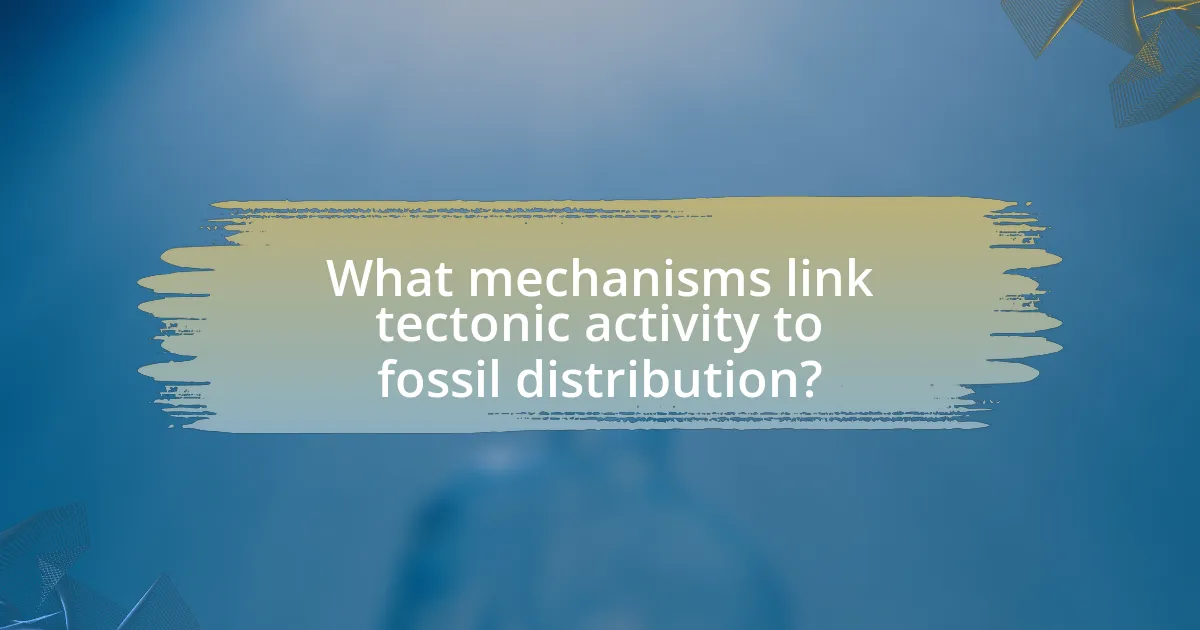
What mechanisms link tectonic activity to fossil distribution?
Tectonic activity influences fossil distribution primarily through processes such as continental drift, mountain building, and volcanic activity. Continental drift, driven by plate tectonics, alters the geographical arrangement of landmasses, leading to changes in climate and habitat that affect where species can thrive and leave fossils. For instance, the breakup of Pangaea resulted in distinct biogeographical regions, which can be traced in the fossil record.
Mountain building, or orogeny, creates new environments and alters existing ones, impacting the types of organisms that can inhabit those areas. Fossils found in the Himalayas, for example, indicate that marine organisms once lived there before tectonic uplift transformed the region into a mountain range.
Volcanic activity can also contribute to fossil distribution by creating new landforms and altering ecosystems. The ash and lava from eruptions can preserve organisms in situ, leading to unique fossil deposits. The fossilized remains of organisms found in volcanic tuff layers provide evidence of life during specific geological periods, linking volcanic activity to fossil preservation.
These mechanisms demonstrate how tectonic processes shape the distribution and preservation of fossils across different geological time scales.
How do tectonic movements create new habitats for fossils?
Tectonic movements create new habitats for fossils by altering the Earth’s surface, leading to the formation of new geological structures such as mountains, valleys, and ocean basins. These changes can expose previously buried sediments and fossils to the surface, allowing for their discovery. For instance, the uplift of mountain ranges can reveal sedimentary layers that contain fossils, while the creation of rift valleys can lead to the accumulation of sediments that trap organic material. Additionally, tectonic activity can influence climate and sea levels, further affecting the types of environments where fossils can form and be preserved.
What is the impact of volcanic activity on fossilization?
Volcanic activity can significantly impact fossilization by altering the conditions necessary for the preservation of organic remains. When a volcanic eruption occurs, it can bury organisms under layers of ash and lava, creating an anaerobic environment that slows decomposition and enhances fossilization. For example, the eruption of Mount Vesuvius in 79 AD preserved the city of Pompeii, allowing for the remarkable preservation of artifacts and organic materials. Additionally, volcanic ash can facilitate the rapid burial of remains, which is crucial for fossilization, as it protects them from scavengers and environmental factors that would otherwise lead to decay.
How do mountain-building processes affect fossil locations?
Mountain-building processes, also known as orogeny, significantly affect fossil locations by altering the geological landscape and influencing sediment deposition. As tectonic plates collide, they create uplifted regions where older rock layers may be exposed, allowing fossils to be found at higher elevations. For instance, the uplift of the Himalayas has revealed ancient marine fossils that were originally deposited in oceanic environments, now located thousands of meters above sea level. Additionally, mountain-building can lead to erosion, which redistributes sediments and fossils, potentially moving them from their original locations. This dynamic interaction between tectonic activity and fossil distribution highlights how geological processes can reshape the accessibility and visibility of fossilized remains.
What are the effects of continental drift on fossil distribution?
Continental drift significantly affects fossil distribution by altering the geographical locations of landmasses over geological time. As continents shift, they change the habitats and ecosystems where organisms live, leading to the isolation or mixing of species. For example, the breakup of the supercontinent Pangaea around 200 million years ago resulted in distinct fossil records on separate continents, such as the presence of similar dinosaur fossils in both South America and Africa, indicating that these landmasses were once connected. This movement also influences climate patterns, which can further affect the types of organisms that can survive in specific regions, thereby impacting fossil distribution.
How does the movement of continents influence species migration?
The movement of continents significantly influences species migration by altering habitats and creating barriers or corridors for movement. As tectonic plates shift, they can separate landmasses, leading to geographic isolation, which affects gene flow and can result in speciation. For example, the breakup of the supercontinent Pangaea around 200 million years ago caused species to diverge as they adapted to different environments on newly formed continents. Additionally, the formation of mountain ranges or ocean basins can restrict or facilitate the movement of species, impacting biodiversity and ecosystem dynamics. This phenomenon is supported by fossil evidence showing distinct species distributions that correlate with historical continental configurations.
What historical examples illustrate the impact of continental drift on fossils?
The historical examples illustrating the impact of continental drift on fossils include the distribution of Glossopteris fossils and the presence of similar dinosaur species across continents. Glossopteris, a seed fern, was found in South America, Africa, Antarctica, and India, indicating these landmasses were once connected. Additionally, fossils of the dinosaur Mesosaurus, found in both South America and Africa, support the theory of continental drift, as this freshwater reptile could not have crossed the Atlantic Ocean. These examples demonstrate how the movement of tectonic plates has influenced the geographical distribution of fossils, providing evidence for the theory of continental drift.
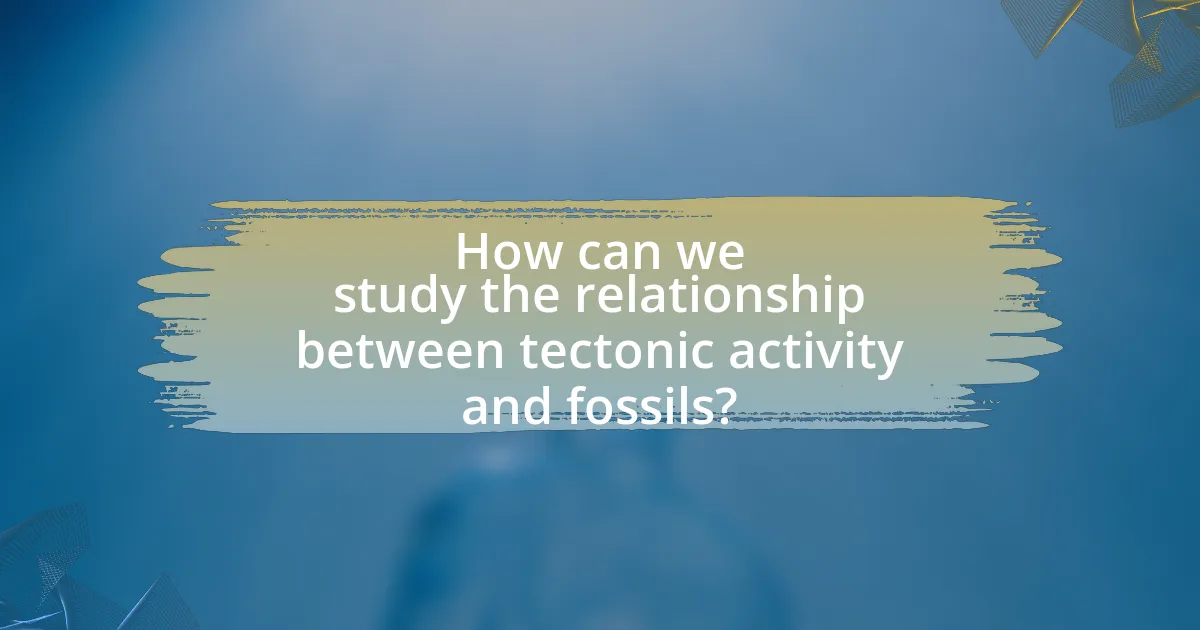
How can we study the relationship between tectonic activity and fossils?
To study the relationship between tectonic activity and fossils, researchers can analyze geological formations and fossil records in areas with varying tectonic histories. By examining sedimentary layers, scientists can identify the age and distribution of fossils in relation to tectonic events such as plate movements, earthquakes, and volcanic activity. For instance, the uplift of mountain ranges can expose older sedimentary layers containing fossils, while subduction zones may lead to the preservation of fossils in unique geological contexts. This method is supported by studies like those conducted by the Geological Society of America, which highlight how tectonic processes influence fossil preservation and distribution patterns over geological time scales.
What methods are used to analyze fossil distribution patterns?
Methods used to analyze fossil distribution patterns include spatial analysis, statistical modeling, and geographic information systems (GIS). Spatial analysis involves mapping fossil locations to identify patterns and correlations with geological features. Statistical modeling, such as regression analysis, helps quantify relationships between fossil distribution and environmental variables. GIS integrates spatial data to visualize and analyze the distribution of fossils in relation to tectonic activity, allowing researchers to assess how geological processes influence fossil locations. These methods collectively enhance the understanding of fossil distribution in the context of tectonic activity.
How do geologists use mapping techniques to study fossils?
Geologists use mapping techniques to study fossils by creating detailed geological maps that illustrate the distribution, age, and type of rock formations where fossils are found. These maps help geologists identify patterns in fossil distribution that correlate with tectonic activity, such as plate movements and the formation of sedimentary basins. For instance, the presence of certain fossils in specific strata can indicate past environmental conditions influenced by tectonic shifts. By analyzing these maps, geologists can reconstruct ancient ecosystems and understand how tectonic processes have shaped the distribution of fossilized remains over geological time.
What role does technology play in fossil analysis?
Technology plays a crucial role in fossil analysis by enhancing the methods used to examine, date, and interpret fossils. Advanced imaging techniques, such as X-ray computed tomography (CT) and scanning electron microscopy (SEM), allow scientists to visualize internal structures of fossils without damaging them, providing insights into their morphology and development. Additionally, technologies like isotopic analysis and radiometric dating enable precise age determination, which is essential for understanding the temporal context of fossil distribution in relation to tectonic activity. For instance, the use of laser ablation inductively coupled plasma mass spectrometry (LA-ICP-MS) has revolutionized the analysis of trace elements in fossils, offering clues about the environmental conditions during their formation. These technological advancements collectively improve the accuracy and efficiency of fossil analysis, facilitating a deeper understanding of how tectonic processes influence fossil distribution over geological time.
What challenges do researchers face in studying this relationship?
Researchers face several challenges in studying the relationship between tectonic activity and fossil distribution. One significant challenge is the difficulty in obtaining accurate geological data, as tectonic processes can alter the landscape and obscure fossil evidence. Additionally, the temporal scale of tectonic activity often spans millions of years, making it challenging to correlate fossil records with specific tectonic events. Furthermore, researchers must contend with the incomplete nature of the fossil record, which can lead to gaps in understanding how tectonic shifts influenced biodiversity over time. These challenges are compounded by the need for interdisciplinary approaches, requiring expertise in geology, paleontology, and geophysics to fully understand the complex interactions at play.
How does erosion affect fossil preservation?
Erosion negatively impacts fossil preservation by removing sedimentary layers that protect fossils from exposure and degradation. When erosion occurs, it can lead to the physical disintegration of fossil-bearing rock formations, which increases the likelihood of fossils being damaged or destroyed. For instance, studies have shown that areas with high erosion rates, such as riverbanks or coastal cliffs, often yield fewer well-preserved fossils compared to more stable environments. This is because the continuous removal of protective layers exposes fossils to weathering, biological activity, and other destructive processes.
What limitations exist in current fossil record data?
Current fossil record data is limited by several factors, including incomplete preservation, geographic bias, and temporal gaps. Incomplete preservation occurs because not all organisms fossilize, leading to a skewed representation of biodiversity. Geographic bias arises as certain environments, like river deltas or lake beds, are more conducive to fossilization than others, resulting in uneven distribution of fossils across different regions. Temporal gaps exist due to the incompleteness of the geological record, where significant periods may lack fossil evidence, hindering the understanding of evolutionary timelines. These limitations affect the accuracy of reconstructing past ecosystems and understanding the impact of tectonic activity on fossil distribution.
What practical insights can we gain from understanding tectonic activity and fossil distribution?
Understanding tectonic activity and fossil distribution provides practical insights into the historical climate, biodiversity, and geological processes of Earth. By analyzing the movement of tectonic plates, scientists can trace the past locations of continents and oceans, revealing how these shifts influenced the distribution of various species over time. For instance, the breakup of Pangaea led to distinct evolutionary paths for flora and fauna, as evidenced by the unique species found on isolated landmasses like Madagascar and Australia. Additionally, fossil records aligned with tectonic events, such as mass extinctions linked to volcanic activity or continental drift, offer critical data for predicting future biodiversity patterns and ecological responses to climate change. This understanding aids in conservation efforts and informs resource management strategies by highlighting regions of high biodiversity that may be vulnerable to tectonic shifts.
How can this knowledge inform conservation efforts?
Understanding how tectonic activity shapes fossil distribution can significantly inform conservation efforts by highlighting areas of high biodiversity and unique ecosystems that may be at risk. For instance, regions where tectonic plates converge often create diverse habitats, such as mountain ranges and rift valleys, which support a variety of species. This knowledge allows conservationists to prioritize these areas for protection and restoration, ensuring that critical habitats are preserved. Additionally, recognizing the historical patterns of fossil distribution can help predict how current climate change may affect species migration and survival, enabling proactive measures to mitigate potential threats. Studies have shown that areas with rich fossil records often correlate with high levels of endemism, underscoring the importance of these regions in conservation planning.
What implications does this have for predicting future biodiversity trends?
Tectonic activity significantly influences future biodiversity trends by altering habitats and creating barriers to species migration. The movement of tectonic plates can lead to the formation of mountains, ocean basins, and rift valleys, which can isolate populations and promote speciation. For instance, the uplift of the Himalayas has resulted in distinct ecological zones, fostering diverse species adapted to varying altitudes and climates. Additionally, tectonic shifts can trigger volcanic activity, which can both destroy existing ecosystems and create new ones, as seen in the aftermath of the 1980 Mount St. Helens eruption, where new habitats emerged, leading to rapid ecological succession. These geological processes are crucial for understanding how biodiversity may evolve in response to changing landscapes over time.
